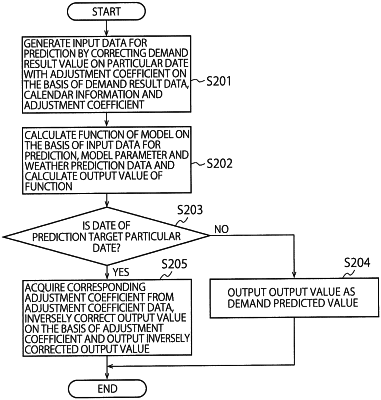| CPC G06Q 10/06314 (2013.01) [G06N 20/00 (2019.01); G06Q 10/04 (2013.01); G06Q 10/109 (2013.01)] | 9 Claims |

|
1. A prediction device comprising:
a hardware storage configured to store demand result data including a plurality of demand result values on a plurality of dates and calendar data including information identifying whether the plurality of dates are particular dates or not, a date that is a particular date including a holiday, a non-particular date that is not the particular date including a weekday, the demand result values being result values of electric power supply amounts supplied in a supply area of an electric power company, and a number of dates with the non-particular date being greater than a number of dates with the particular date;
adjustment coefficient calculation circuitry configured to:
identify the particular dates based on the calendar data,
calculate a number of elapsed days in a year, corresponding to each of the particular dates,
calculate an adjustment coefficient for each of the particular dates based on the demand result data, and
generate an adjustment coefficient database that maps the number of elapsed days in the year to the adjustment coefficient;
adjustment coefficient determination circuitry configured to:
receive a request to obtain an adjustment coefficient for a specified date,
calculate a number of elapsed days in a year for the specified date,
identify, in the adjustment coefficient database, a number of elapsed days closest to the calculated elapsed days,
obtain from the adjustment coefficient database an adjustment coefficient corresponding to the identified elapsed days, and
return the obtained adjustment coefficient to a source of the request;
model learner circuitry configured to:
judge whether each date in the demand result data is the particular date or not based on the calendar data, and if the date is the particular date, send a request to the adjustment coefficient determination circuitry to obtain the adjustment coefficient for the date,
divide one of the demand result values on a date corresponding to the particular date among the plurality of dates by the obtained adjustment coefficient to acquire a first normalized demand result value, and
generate, by machine learning, a prediction model for predicting a demand value on any date on a basis of the first normalized demand result value, which is received as learning data for the machine learning, on the date corresponding to the particular date and ones of the demand result values on dates corresponding to the non-particular date among the plurality of dates, the prediction model having input variables each assigned one of the first normalized demand result or one of the demand result values on one or more dates before the any date, having an output variable of a predicted demand value;
input circuitry configured to receive information of a target date for demand prediction specified by a user; and
predictor circuitry configured to:
specify dates before the target date for demand prediction, wherein a number of the dates before the target date is identical to a number of the input variables in the prediction model,
judge whether the specified date is the particular date or not, and if the specified date is the particular date, send a request to the adjustment coefficient determination circuitry to obtain the adjustment coefficient for the specified date,
divide one of the demand result values on the date corresponding to the particular date among the demand result values of the specified dates by the obtained adjustment coefficient to acquire a second normalized demand result value,
predict a demand value on the target date based on the prediction model in which the input variables are assigned the second normalized demand result value on the date corresponding to the particular date and the demand result values on the dates corresponding to the non-particular date among the specified dates,
judge whether the target date is the particular date or not based on the calendar data, and if the target date is the particular date, send a request to the adjustment coefficient determination circuitry to obtain the adjustment coefficient for the target date, and
multiply the predicted demand value by the obtained adjustment coefficient to acquire an inversely-normalized predicted demand value if the target date corresponds to the particular date, the inversely-normalized predicted demand value being a prediction demand value of the particular date, wherein
the predicted demand value is a prediction demand value of the non-particular date if the target date corresponds to the non-particular date,
the predicted demand value is a predicted value of the electric power supply amount,
electric power supply on the target date to the supply area by the electric power company is controlled based on the predicted demand value on the target date, and
the adjustment coefficient calculation circuitry is configured to:
calculate a mean value of first ones of the demand result values and second ones of the demand result values for each of a plurality of particular dates,
the first ones of the demand result values being demand result values on dates corresponding to the non-particular date among one or more dates before the date corresponding to each of the particular dates based on the demand result data, and
the second ones of the demand result values being demand result values on dates corresponding to the non-particular date among one or more dates after the date corresponding to each of the particular dates; and
calculate the adjustment coefficient for each of the particular dates based on a ratio between one of the demand result values on the date corresponding to each of the particular dates and the mean value.
|